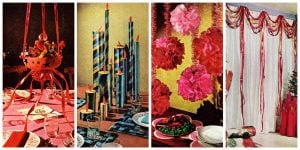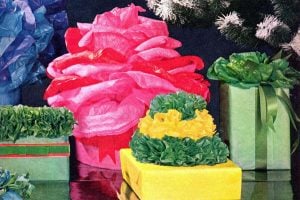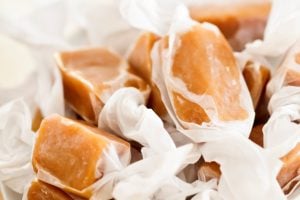A Victorian Christmas dinner: One of the most important features of the day
Christine Terhune Herrick gives some timely directions as to how the dining room should be decked and how the dishes should be prepared and served
A varied and delicious array of good things to eat
The dinner is one of the most important features of Christmas day. Perhaps it might even be called the most important. For while we could imagine a Christmas without snow, without Church, without a tree — even without presents or hanging up stockings (although the last requires a powerful effort of the imagination) — it is almost impossible to make a mental picture of a Christmas without a dinner.
The dinner must be of a certain sort, too. No make-shifts will serve today. The best of everything is hardly good enough, and due respect must be observed for tradition. There are dishes which must appear, if all precedent is not to be violated, and everything connected with the feast must be brilliant with jubilations and good cheer.
To begin with, the dining room should be decked out with evergreens, holly and mistletoe. The table will probably be drawn to its full length, for this is not a day for small parties. If the family is not large enough to make an imposing array, the number should be swelled by the presence of guests who have no homes of their own.

Only the finest damask must be used today. The pure white of the tablecloth should be brightened by a centerpiece of flowers or of holly, and a breast-knot or boutonniere of the same should be at each plate. Pretty, fancy dishes of candies, olives, radishes, celery, pickles, jellies, salted nuts, etc., are placed here and there with a judicious eye to the effect.
At each place is a plate, to the left is an array of forks, one for each course. To the right should be the knives to match, and the folded napkin with a piece of bread upon it. The water glass is between these and the middle of the table. The soup spoon is laid at right angles to the knives and forks, the butter or bread-and-butter plate is at the left hand and the salt cellar is near the glass.
But all this is the mere skeleton of the feast. What we are to eat is of more importance than the fashion in which it is served, but yet the enjoyment of even the best cooked meal is heightened if it is eaten from pretty china and amid pleasant surroundings.

From the very first course
The dinner begins, of course, with soup, and as to some people, a ceremonious repast of many courses is out of place on Christmas Day — the first and the second courses may be merged into one by serving an oyster bisque. This does away with the necessity for a fish course, and we go on from that directly to the main part of the meal, the turkey and its adjunct.
On such an occasion, half the aroma of the feast is lost if the turkey is carved on the sideboard or in the pantry. Everyone desires to witness the operation and encourage the carver with praise or confuse him with banter. The big, beautifully browned bird is placed in front of the head of the house and kept in countenance at the other end of the table by a mighty Christmas pie.
No one will be critical today if the usual custom of passing the vegetables from the sideboard is omitted and if sweet potatoes, white potatoes, oyster-plant boiled rice and other vegetables take their place on the table along with the cranberry and the celery. The only advantage gained by their absence is more room for the articles already on the table.
After so substantial a course as this, and in anticipation of the sweets that must follow, nothing heavier is desirable for a salad course than lettuce with a French dressing. All the other eatables are cleared from the table, except the dishes of bon-bons and salted nuts and the olives or radishes that are to be eaten with the salad, crackers and cheese.

A further clearance of dishes and the brushing off of crumbs precede the appearance of the mince-pie and plum-pudding of honored memory. To some feasters, the dinner would be incomplete without ice cream, and this is excellent for the children who are not permitted to eat the richer dainties with which their elders tempt Providence and torture their digestions. A great Christmas cake may also accompany the ices.
When all this is finally eaten, the Event of the Day may be concluded by fruit, nuts, raisins, bon bons and the small cup of black coffee that is often a saving clause as a “settler” after a heavy dinner.
The hour for the dinner is to be determined by circumstances. If children are admitted to it, it is better to have the meal near the middle of the day, or at least not later than two or three o’clock. But where grown people only are to be considered, their preference is usually for six, six-thirty or seven o’clock, when they can feel that they may devote the concluding hours of the holiday to repose and digestion.
Victorian Christmas dinner: One Christmas menu
Oyster Bisque.
Roast Turkey.
Chicken Pie.
White Potato Puff. Baked Sweet Potatoes.
Boiled Rice. Stewed Oyster Plant.
Creamed Spinach.
Celery. Cranberry Jelly.
Lettuce with French Dressing.
Water Crackers. Cream Cheese.
Olives. Salted Almonds. Radishes.
Mince Pie. Plum Pudding.
Ice Cream.
Christmas Cake.
Fruit. Nuts. Raisins. Bonbons.
Coffee.



















